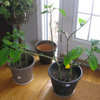Hi. I am an independent plant breeder and researcher. I have been interested in the phenomenon of tricotyledon seedlings since 1997.
I first came across the phenomenon in radish seedlings which i was crossing at the time. I found the ratio to be about one in 43 seedlings is a tricotyledon on the average.
Being intriquued i then looked to see if it occurs in other varieties of plants. I have found it in artemisia, marigolds, and the opuntia...Prickly Pear. All seem to have the same one in 43 seedling ratio of tricotyledons to regular seedlings. I believe this is a genetically transmitted characteristic. I self crossed a tricotyledon marigold and the seedlings from this cross increased the incidence of tricotyledons to 1 in 13 seedlings exhibited the tricotyledon character. I also have found a four leaved seedling in my radish hybrid seedlings and this confirms my theory that this is a somatic hybrid caused by a fusion of two seed embryos. In layman terms that means a siamese twin conjoined plant seedling. That is two fused seedlings, growing as one plant. I thought this would make a stronger plant, but it turns out that these tricots are weaker than the normal plants.
Hope my humble research findings have helped you some.
Here's a new theory. I believe that the tricots are evident throughout the whole plant kingdom and are always in the ration of 1 tricotyledon to every 43 normal seedlings. Give me feedback on this. If the theory is correct it could be used as a plant kingdom genetic marker irregardless of genera or species.






theraglady47
bolrogOriginal Author
Related Discussions
I have a question on my old brugmansia
Q
Question on planting brugmansia in pots sunk in the ground
Q
Brugmansia seed pod question
Q
Brugmansia seedlings question
Q
ruth_ann
bolrogOriginal Author
julie_2009
HU-659352804